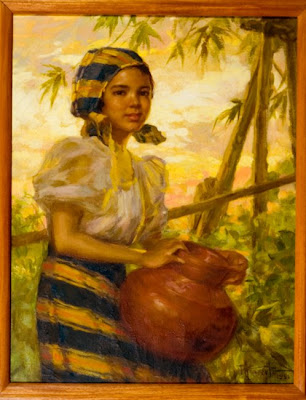 Katipunan
Katipunan Education - mural (1964)
Education - mural (1964) Muslim Wedding (1958)
Muslim Wedding (1958) Rajah Soliman
Rajah Soliman Mangingisda (Fishermen) - (1957)
Mangingisda (Fishermen) - (1957) Lapu- Lapu (1964)
Lapu- Lapu (1964) Fiesta With Higantes
Fiesta With Higantes The Cockfight
The Cockfight Bayanihan (1962)
Bayanihan (1962)
Carlos V. Francisco (1914-1969)
In 1973, Carlos “Botong” Francisco was the second Filipino to receive the title of National Artist in Painting, after Fernando C. Amorsolo. Also known as the Poet of Angono, he single-handedly brought back the art of mural painting in the Philippines and was its most distinguished painter in his time. He was on the forefront of modernist art in the country, and with Victorio C. Edades and Galo B. Ocampo became part of “The Triumvirate” of modern art. His is best known for his historical epics, and one of his favorite subjects is fisherfolk. His images of women came from mythology, history, legend, customs and contemporary life.
On November 4, 1914, Francisco was born to Felipe Francisco and Maria Villaluz in Angono, Rizal. He went to college at the University of the Philippines School of Fine Arts, and before the Second World War did illustrations for The Tribune and La Vanguardia. Although he came from the same school of arts as Amorsolo, he veered away from the style of the traditional artist and developed a modernist style. Together with Victorio Edades and Fermin Sanchez, he painted for the Manila Grand Opera House and the Clover Theater. He and Edades started mural-painting, and together they formed the Thirteen Moderns, a group of modernists, in 1938.
After the Second World War, he taught at the University of Santo Tomas School of Fine Arts at the same time that he was doing work in cinema with Manuel Conde. He worked as a scriptwriter for films such as “Genghis Khan,” “Putol na Kampilan,” and “Tatlong Labuyo.” In addition, he designed costumes for films such as “Romeo at Julieta,” “Prinsipe Tenoso,” “Ibong Adarna,” “Siete Infantes de Lara,” and the “Juan Tamad” series.
Francisco further enhanced his art in mural painting as he, together with Edades and Ocampo, was commissioned to do several murals for lobbies and private residences. They developed the Filipino imagery in their work, taking images from the customs and traditions of the people. Some of the murals they worked on as a triumvirate are Rising Philippines for the Capitol Theater, murals for the Golden Gate Exposition, the State Theater, and the private residences of President Manuel Quezon, Ernesto Rufino and Vicente Rufino. However, his major masterpiece is the mural he did for the Bulwagang Katipunan of the Manila City Hall.
After Francisco’s death on March 31, 1969, what came to be known as the Botong Francisco School of Painting grew, exemplifying lyricism and heroism.
His major works include:
• 1945 – Kaingin
• 1948 – Fiesta
• 1953 – 50 Years of Philippine History, his first important mural, for the International Fair held in Manila
• 1954 – Life and Miracles of St. Dominic, for Santo Domingo Church
• 1956 – Stations of the Cross, for the Far Eastern University
• 1956 – The Invasion of Limahong
• 1957 – Mangingisda
• 1958 – Muslim Wedding
• 1962 – Bayanihan
Achievements:
• 1948 – 1st Prize, First National Art Exhibition of the Art Association of the Philippines, for Kaingin
• 1964 – Patnubay ng Sining at Kalinangan, from the City of Manila
Sourced at Cultural Heritage, Phantom Bookshop- Ventura, California
Tags: Great Filipino Painters, National Artist, Carlos "Botong" Francisco, Angono, Rizal, Philippines, National Commission For Culture and the Arts, National Museum of the Philippines, Wikipedia, Pinoy Wikipedia, Great Masters, Philippines
Posted by: Mel Avila Alarilla

































_-_The_Old_Mill_(1888).jpg)













